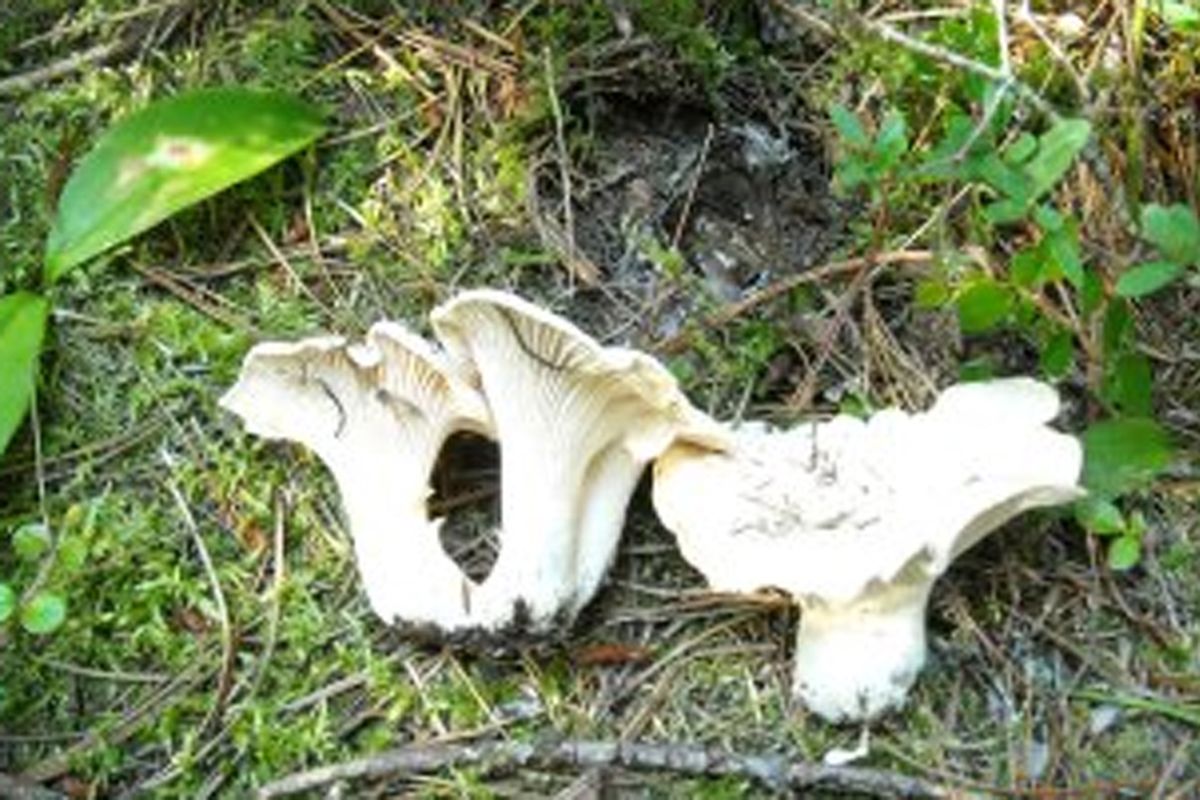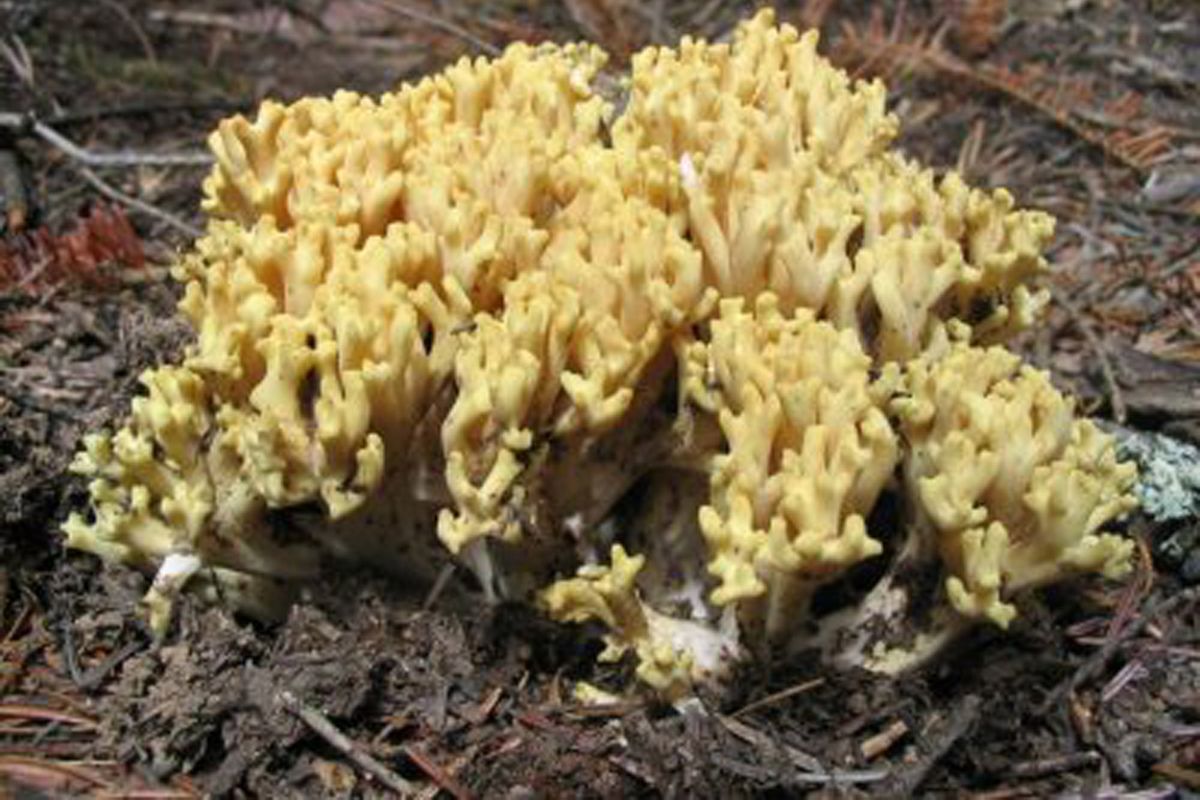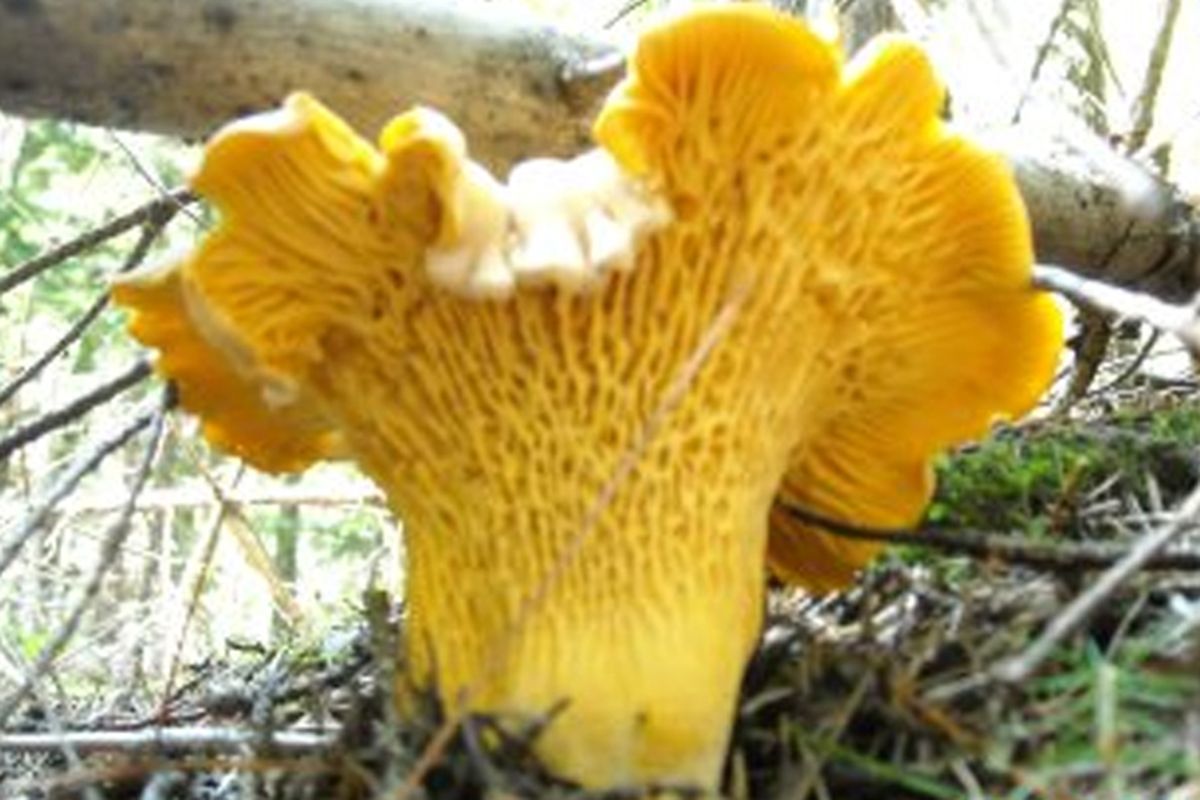Foraging for fungi
Hunting for mushrooms requires special knowledge
Ramaria rascilaspora, or Yellow Coral Photos courtesy of Lynda Foreman (Photos courtesy of Lynda Foreman / The Spokesman-Review)
Pale yellow chanterelles, fragrant anise mushrooms, distinctive coral fungi and thousands of other species have been prized for centuries.
In China, mushrooms have been used in cooking and medicinally for more than 2,000 years. The Japanese value the shiitake mushroom for its ability to strengthen the immune system with naturally occurring antibiotic substances.
What it so appealing about digging around in the dirt for often strange-looking, sometimes poisonous fungi?
Lynda Foreman, a member of the Spokane Mushroom Club since 1982, explains.
“I enjoy the hunt, walking around in the woods. I love being in the mountains,” she said. “Some of the mushrooms are beautiful, elegant.”
While she won’t give away her secret hunting spots, Foreman did share that one of the best ways to find edible mushrooms is to become familiar with their habitats.
Many have a symbiotic relationship with certain tree species. Looking for King Boletes? They feed on Norway Spruce. Hunting for morels? Look under old apple trees or dead elms.
Foreman has developed a wealth of knowledge over the years, and is often called on to identify mushrooms. She also leads field trips, known as forays, to search for mushrooms in areas where specific types are known to grow.
Wild mushrooms fruit in the fall and spring, and twice a year the club holds a weekend foray at Priest Lake. Members gather the mushrooms, sort and identify them.
“These hands-on learning sessions are the best way to remember what you’ve found in the woods and help everyone learn more about mushrooms,” Foreman said.
Cleaning and preserving
To clean firm mushrooms, tap them gently to shake out the dirt, then wipe them with a terry cloth towel. It’s OK to rinse them, but use water sparingly as mushrooms absorb it readily, diluting their flavor and changing their texture.
Keep fresh mushrooms in the refrigerator in a paper bag, never in plastic, which can trap moisture and cause them to spoil quickly.
For mushrooms that you don’t plan to eat right away, Foreman recommends drying them. Slice the cleaned mushrooms to a maximum thickness of ¼-inch and place them in a dehydrator.
If you don’t have a dehydrator, place the mushrooms in a single layer on a cloth towel inside a cardboard box with a fan blowing directly on them. Let them dry for 24 hours.
“They should be as hard as wood. If there is any moisture, they’ll mold,” warns Foreman.
Hill’s Resort at Priest Lake serves about 200 pounds of morels each year in its restaurant.
Chef Scott Hill freezes morels by first soaking them in cold salt water for about 20 minutes to remove any unwanted debris, then placing them on sheet pans in the freezer. He transfers them to zip-top bags once frozen.
“The water forms a protective barrier – they freeze better after soaking,” he said.
As for chanterelles, Hill recommends sautéing them with onion, white wine and butter and freezing them in small portions to be added to recipes later.
“Don’t dry them – they get tough and the flavor changes,” he said.
If you are lucky enough to have leftover chanterelles, morels or Caesar’s mushrooms, you can also preserve them in butter.
“The Practical Mushroom Encyclopedia,” by Peter Jordan and Steven Wheeler, gives the following instructions for wild mushroom butter:
Sauté 1 pound of cleaned, chopped mushrooms in 4 tablespoons of butter over gentle heat for 2 to 3 minutes. When the mushrooms have cooled, combine them with 8 tablespoons (1 stick) of softened butter. Spoon the mixture into waxed paper and roll up in a cigar shape, twisting the ends closed.
Wild mushroom butter can be melted and served over grilled meats and fish, or added to soups and sauces. Store it in the refrigerator for up to 10 days or freeze for up to eight weeks.
Rich in flavor
Different species have distinct flavors, ranging from smoky and earthy to peppery hot. This variety makes wild mushrooms a great way to add flavor, texture and aroma to a multitude of dishes.
Foreman describes honey mushrooms as “the sweetest and best tasting”; chanterelles “taste and smell like apricots.”
Rich in amino acids, potassium, and vitamins D and B, mushrooms are sometimes considered an economical and nutritious replacement to meat.
Mushrooms pair well with other rich foods, such as cream sauces, scrambled eggs or wild game. But many find the best way to eat them is simply sautéed in butter.
“The way I like mushrooms best is serving them as an appetizer. They hold their flavor really well,” said Hill.
He explained that dried mushrooms have a very pronounced flavor, so only a small amount is necessary. To rehydrate them, soak in warm water for about 20 minutes; save the liquid, which can be used to flavor soups and other dishes.
Safety first
“Don’t eat any wild mushrooms raw, especially morels,” said Foreman. “All mushrooms must be thoroughly cooked, even dried ones.”
She explained that certain mushrooms contain enzymes (which are neutralized by cooking) that are hard to digest, making people sick. She also stressed that it is important to use a local field guide to identify mushrooms, since a Shaggy Mane growing in our area might look very different from the picture in a guide book written in Illinois.
If you can’t identify it, throw it out.
Foreman recommends the field guide “Mushrooms Demystified,” by David Arora.
Tips for beginners
The best way to learn is to go with a knowledgeable mushroom hunter who can identify the different species. Always keep a sample of mushrooms you plan to eat, so if something does go wrong, you’ll know what you’ve eaten.
Joining a club is a great way to learn from other experienced mushroom collectors. The Spokane Mushroom Club’s monthly meetings feature guest speakers, slide shows and field trips.
“Our mission is to educate amateurs – teach them what is safe,” said Foreman.
Chicken and Morels in Parmesan Cream Sauce
Courtesy of Scott Hill, Hill’s Resort at Priest Lake, Idaho.
For the morel sauce:
2 ½ teaspoons minced garlic
2 ½ teaspoons minced shallots
4 cups morel mushrooms
¼ cup white wine
1 ½ teaspoons brandy
2 cups whipping cream
Salt and pepper
For the chicken:
1 1/2 pounds boneless chicken breast, cut into thin strips
1 teaspoon minced garlic
1 teaspoon minced shallots
2 tablespoons white wine
½ cup freshly grated Parmesan cheese
1 pound linguine, cooked
¾ cup Asiago cheese, for garnish
Parsley for garnish
Prepare the morel sauce: Sauté garlic, shallot and 2 cups of the morels for about 5 minutes. Deglaze with white wine and brandy. Cook 3 minutes and add the cream.
Reduce heat to low and reduce by half. Add the rest of the morels and salt and pepper to taste. Set aside.
Sauté chicken breast with garlic and shallot, deglaze with white wine and add morel sauce. When the sauce is hot and slightly thick, take off the heat and add parmesan cheese. Serve over hot linguine and top with Asiago cheese and parsley.
Yield: 6 servings
Easy Mushroom Squares
Courtesy of JoAnn Groth, Spokane Mushroom Club.
3 cups chopped wild mushrooms
¼ cup finely chopped onion
½ teaspoon Worcestershire sauce
2 tablespoons butter
2 cups Bisquick baking mix
½ cup butter
¼ cup boiling water
1 (3-ounce) package cream cheese, softened
¼ cup grated parmesan cheese
Preheat oven to 350 degrees. Grease a 9- by 13-inch pan.
Sauté mushrooms, onion and Worcestershire sauce in 2 tablespoons butter until slightly brown.
In separate bowl, mix baking mix and ½ cup butter until it forms pea-size balls of dough. Add boiling water and beat until soft dough forms.
Spread dough in greased pan. Spread softened cream cheese over dough. Top with mushroom mixture and then parmesan cheese.
Bake until crust is golden brown, about 20 to 25 minutes. Cool and cut into 1 ½-inch squares. Leftovers can be stored in refrigerator and reheated later.
Yield: 48 squares
Hill’s Morel Mushroom Appetizer
Courtesy of Scott Hill, Hill’s Resort, Priest Lake, Idaho.
1 ounce olive oil
8 ounces fresh or frozen morel mushrooms
¼ diced white onion
1 ounce clarified butter (see note)
3 ounces dry white wine
3 ounces chicken stock
Pinch of salt and white pepper
3 ounces cold butter chunks
4 slices bread, toasted, buttered and sprinkled with parmesan cheese
Heat a sauté pan until almost smoking. Add olive oil, mushrooms, onions and clarified butter. Cook on high heat about 5 minutes, until the mushrooms start to brown.
Deglaze with white wine and chicken stock. Reduce for a few minutes and add the salt, white pepper and butter chunks. There should be a sauce around the mushrooms; if not, add a small amount of chicken stock and a few more butter chunks.
Serve with parmesan toast points.
Note: To clarify butter, heat it in a saucepan until frothy. Skim froth from surface and pour clear melted (clarified) butter into separate container, discarding milk solids at bottom of pan.
Yield: 4 (2-ounce) servings
Wild Mushroom Spread
Courtesy of JoAnn Groth, Spokane Mushroom Club.
8 ounces wild mushrooms
2 tablespoons chopped onion
1 clove minced garlic
1 tablespoon butter
3 ounces softened cream cheese
1/4 teaspoon salt
1/4 teaspoon dried basil
1/2 teaspoon dried parsley
Clean and chop mushrooms and sauté with onion and garlic in butter until tender.
Mix cream cheese, salt and herbs in a small glass bowl. Add sautéed mushrooms, mix and let cool. Spread on crackers or cocktail rye bread.
Yield: About 1 cup





